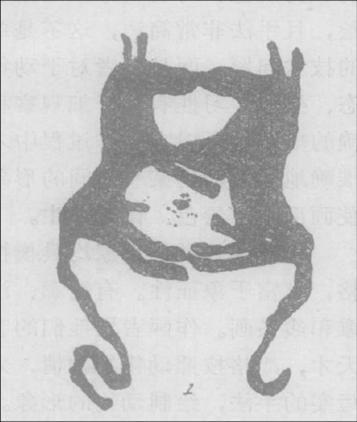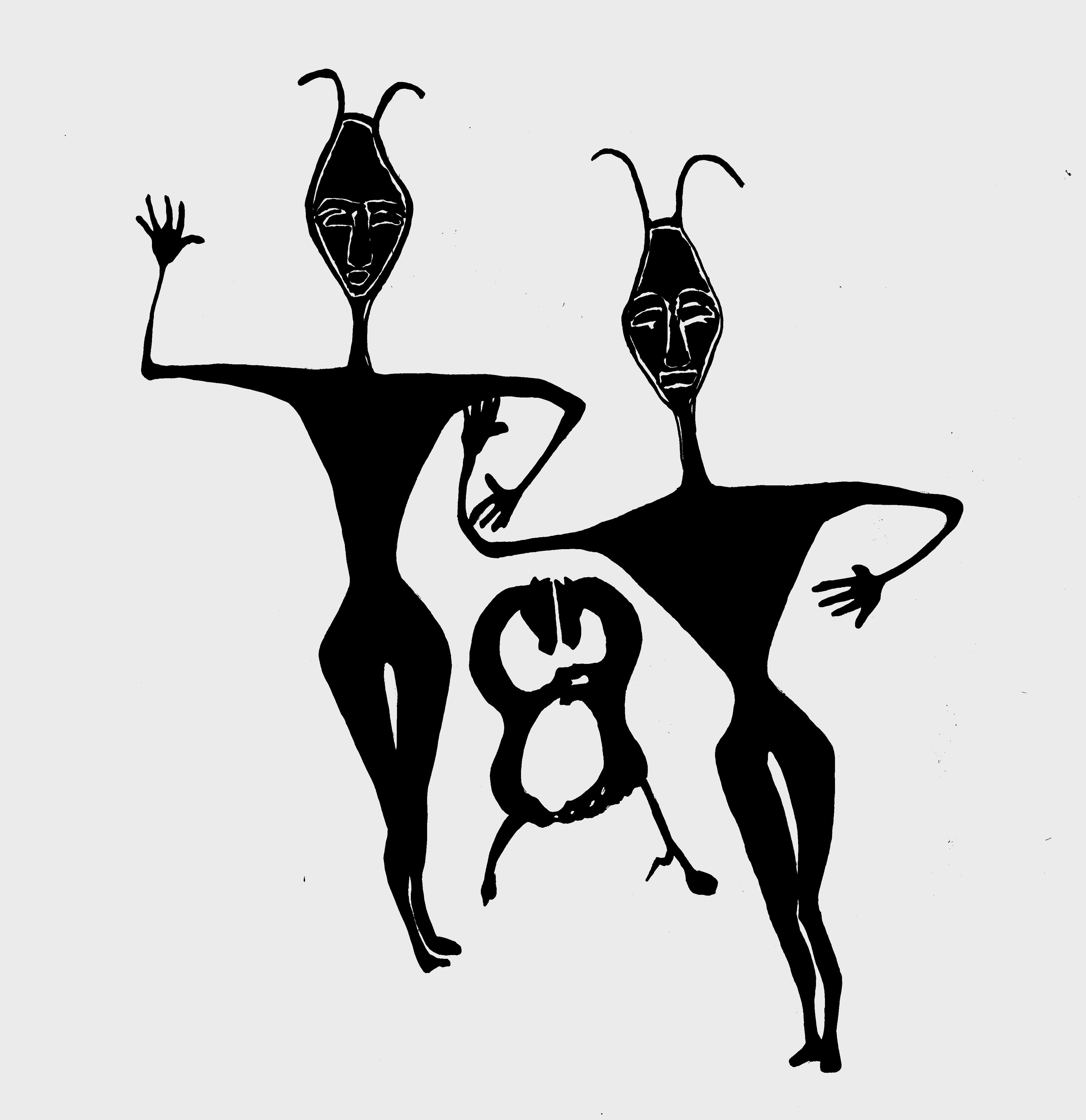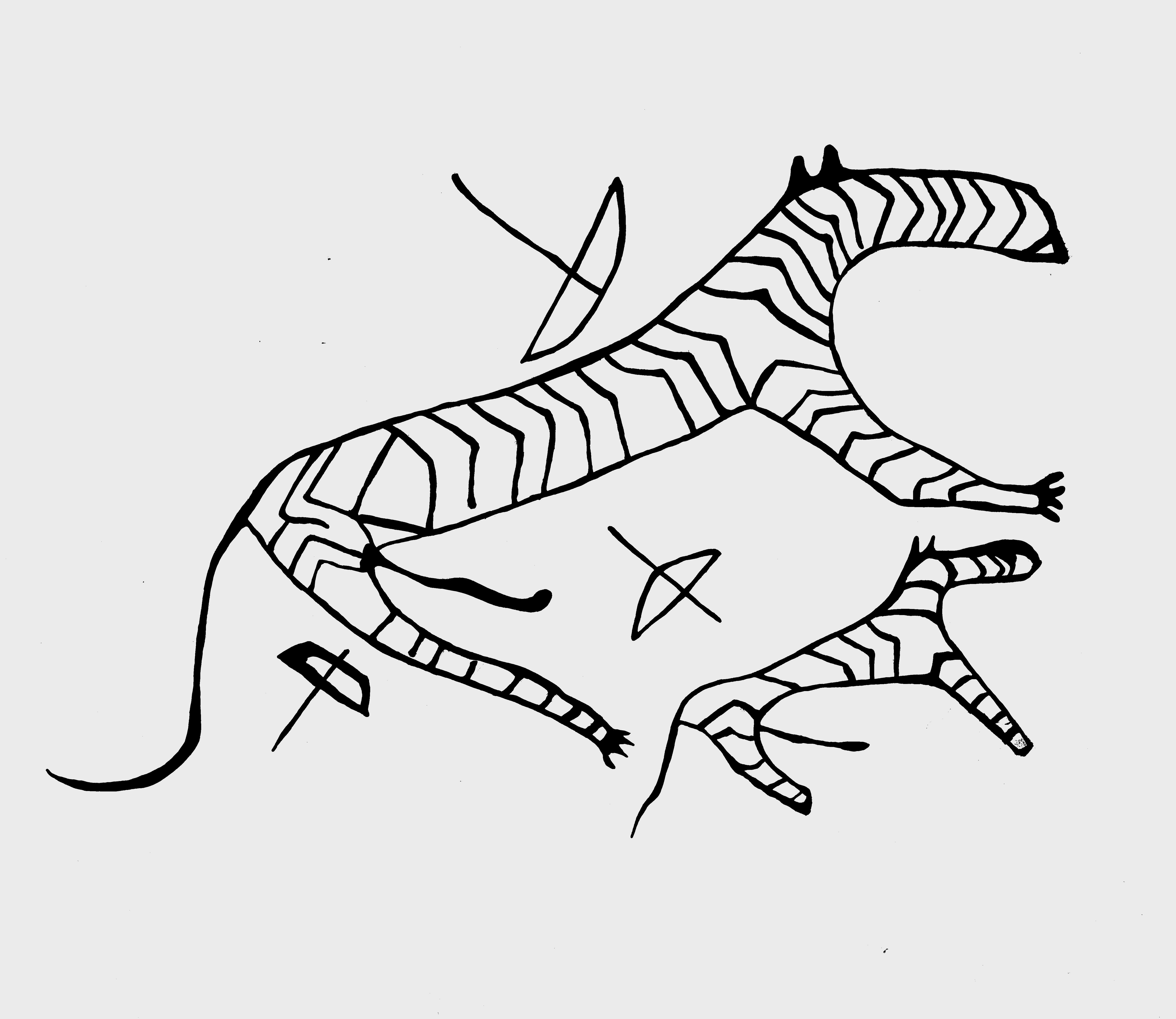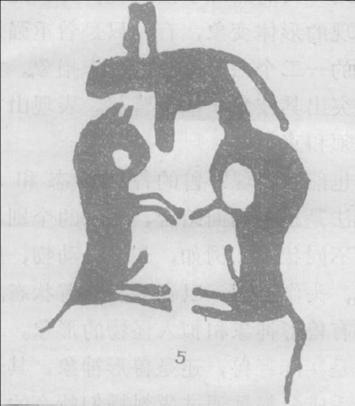Photo credit: Gai Shan Shan. On the artistic achievements of Yinshan rock painting. [J] Northern Cultural Relics, No.2, 1982; Page 79
"Heart-Object Correspondence": The Principle of Gestalt in Tribal Totems
As an important part of the Shimenzi rock paintings, the "Dui Ma Tu" (Pair of Horses) has become a symbol of unifying social function and form; at the same time, the "Dui Ma Tu" also conforms to some principles in Gestalt visual perception. The following will analyze the related visual principles.
Firstly, the "Dui Ma Tu" embodies the principle of "closure" in Gestalt theory. The "Dui Ma Tu" forms a connected and closed figure. The unity and symmetry of the form: both contact and combine to form a whole, while maintaining two relatively independent images. Compared with the "Hunting Tiger" picture with bows and arrows around, the "Dui Ma Tu" obviously conforms to the "pair relationship" of the two components touching each other, thus producing a visually significant and complete figure. Therefore, the "Dui Ma Tu" in the Shimenzi rock paintings just uses the visual principle of "Closure" to create a tribal totem with eternal meaning - two parts that support and oppose each other, forming a unified whole with corresponding relationships.
Secondly, the two components of the "Dui Ma Tu" in the Shimenzi rock paintings are similar in form, emphasizing left-right symmetry and integrity, forming an abstract changing figure. The two horses in the "Dui Ma Tu" have the same shape, the symmetrical layout is balanced and ingenious, forming a structure that is both opposing and echoing, which not only has aesthetic value, but also ethnic cultural connotations. Arnheim in "Art and Visual Perception" mentioned: "The role of 'similarity' is not limited to the objects looking like they 'belong to a group'. Similar units can further form a certain pattern." He also used the expressions "size similarity" and "shape similarity" to try to explain the principle of visual combination of different units in close positions. The "Dui Ma Tu" maintains balance and integrity with equal left and right forms, which is actually what Kurt Koffka mentioned: "When the distribution of forces is absolutely homogeneous on the sensory surface, this simplest example can be realized."
It is the decorative and visual closure effect of the "Dui Ma Tu" that highlights its uniqueness in the Shimenzi rock paintings. Other images (characters or animals) in the Shimenzi rock paintings are all life scenes of early nomadic tribes: hunting, reproduction, and dance, etc., and do not show formal symmetry and echoing relationships. Although some of the characters in the rock paintings are in similar postures and arranged in order, they are not symmetrical structures, nor do they reflect the visual principles of the "Dui Ma Tu".
Thirdly, achieving the "heart-object homomorphism" effect makes the form, content, and visual psychology consistent. The "Dui Ma Tu" meets the unified requirements of vision and perception, showing the painter's grasp of the overall form and the use of visual experience. If analyzed from the perspective of early witchcraft activities, the creation of the "Dui Ma Tu" obviously has a clear purpose, such as to convey and make mysterious "power" rather than to pursue realism. Therefore, the modeling is based on the same type of relative composition. It can be said that the "Dui Ma Tu" has fundamentally different expressive purposes from other images in the rock paintings.
It is necessary to explain that in the previous research, the principles of Gestalt theory reflected by the "Dui Ma Tu" were not involved, but the possible sources and meanings of the images were verified. For example, Wang Binghua tried to include the "Dui Ma Tu" in the discussion of the theme of "horse temple seeking children" reproductive rock paintings. From the analysis of visual images, the "Dui Ma Tu" is obviously a unique symbol of the nomadic tribe, with clear implications and symbolism. Of course, viewing the "Dui Ma Tu" as a tribal symbol does not contradict the discussion of related topics.
The "Dui Ma Tu" in the Shimenzi rock paintings can be considered as a unique emblem or totem of the horse-worshipping nation, and conveys such information: 1. It shows the ethnic characteristics and horse-worshipping customs of the nation; 2. Through the concrete modeling combination, it forms an abstract symbol with symbolic meaning, and the painter has accumulated certain image expression experience; 3. It reflects the early symbol design and decorative art achievements.
On the Ethnic and Stylistic Characteristics of the Kangjia Shimenzi Rock Painting in Hutubi
by Min Wang *
School of Design, Jiangnan University, Wuxi, China
* Author to whom correspondence should be addressed.
JACAC. 2023, 1(1), 10-17;
Received: May 28, 2023 | Accepted: June 28, 2023 | Published: June 23, 2023
Introduction
The rock carvings of Hugubi kangjia Shimenzi (referred to as Shimenzi rock paintings) in Hubei, Xinjiang, are located halfway up the mountain at an altitude of over 1500 meters. They are about 4 meters above the ground and reflect the lifestyle of early nomadic tribes, such as hunting, and events. The "dui ma tu" (pair of horses) in the rock paintings have significant ethnic colors and decorative features, which are valuable for studying the history of ethnic decoration and artistic styling.
Compared to the known rock paintings' side view techniques, this group of "dui ma tu" adopts a composition of two horses facing each other, forming a complete closed figure, reflecting the clever conception and layout of the artist. In terms of expression, the Shimenzi rock paintings exhibit both the use of "frontal view technique" for human figures and the use of "side view technique" for the "dui ma tu". Previous research has mentioned the ethnic and cultural implications of the "dui ma tu" in the Shimenzi rock paintings and provided relevant evidence. In previous analysis, I focused on the frontal modeling of the characters in the Shimenzi rock paintings. Here, I mainly focus on the "side view technique" and analyze the concept of formality reflected in the "dui ma tu" based on some principles of Gestalt psychology, hoping to contribute to new interpretations and discussions.
"Side Law": A Stylistic Perspective Based on Image Integrity
Shimenzi Rock Paintings primarily employ two modes of representation: human figures are depicted using a "frontal law" approach, while animals are consistently portrayed in a "side law" manner. These distinct approaches convey the rock painters' intention to achieve a comprehensive representation of the figures, whether human or animal. "The Duo Ma Tu" (Pair of Horses) is a manifestation of this stylistic perspective, utilizing the "side law" approach and carrying specific cultural information. (Figure 1)
Firstly, the use of the "side law" in the depiction of the dual horse forms in the Shimenzi Rock Paintings reflects the adherence to image integrity. The visual integrity of the representation of figures (human or animal) is a fundamental principle observed in early art and decoration, not unique to "The Duo Ma Tu" of Shimenzi Rock Paintings. For instance, similar approaches are found in the nearby "Hunting Tiger" depiction as well as in rock paintings from northern China, particularly those from the Yin Mountains (Yinshan Rock Paintings) (Figure 1-2). Zhu Di, in his research on primitive culture, affirmed that "many rock paintings appear in the form of silhouettes". Furthermore, the phenomenon of depicting both front and side profiles follows a certain pattern, depending on the need to comprehensively represent different parts without resulting in any "incompleteness" in the image. Gai Shanlin also noted in Yinshan Rock Paintings that "the carving of animals generally only presents their side profile, without the use of perspective or inclined planes... The technique combines front and side profiles, with different parts carved into different states. For example, when carving an animal, the body is depicted in profile and the head is depicted frontally." Thus, it is evident that the use of side profiles or silhouettes, as seen in "The Duo Ma Tu" of Shimenzi Rock Paintings, is a common practice in early rock paintings, aimed at representing the integrity of animal images, and therefore possesses a certain universality.
What is even more similar is that both the Shimenzi Rock Paintings and the Yinshan Rock Paintings in Inner Mongolia utilize the technique of intaglio carving. The characteristic of this technique is that the outer contours of the images are carved deeper (with clear edges and a gradual smooth transition towards the central area, with visible grinding marks), while the inner parts within the contours are polished to be smoother and shallower, similar in height to the outer parts. The "Duo Ma Tu" of Shimenzi Rock Paintings adopts a shallow relief technique of intaglio carving, resulting in a flat and recessed image.
Secondly, the "Duo Ma Tu" in the Shimenzi Rock Paintings is formed by connecting the two side profiles (silhouettes) of the horse, implying a complementary image to present a complete representation of the subject. It can be argued that the "Duo Ma Tu" overcomes, or even compensates for, the limitation of the "silhouette-style" rock carving that can only represent a single side profile, thus fully displaying the morphological features of both sides of the horse. Moreover, the Shimenzi "Duo Ma Tu" depicts corresponding faces of the image, stemming from the understanding and belief in creating a complete image, not merely for aesthetic or formal interest. Therefore, the "Duo Ma Tu" does not use perspective (which may also be related to technical constraints) to reduce the integrity of the image, perhaps influenced by factors such as totem worship.
Thirdly, the Shimenzi Rock Paintings' "Duo Ma Tu" forms a complete pattern suitable for decoration, possessing significant decorative and formal aesthetic appeal. Previous researchers have noted that: "Compared to the style of the full-scale rock paintings, only these two groups of horses are not realistic. They have been patterned, connected head to tail to form a closed, meaningful form." The horse's form has shifted from imitation of the image to processing and organization of the image, becoming a decorative element. If the content of the Shimenzi Rock Paintings and the northern rock paintings is mainly realistic, narrative, or scene depiction, the "Duo Ma Tu" shows characteristics not possessed by other (human or animal) images in these rock paintings — symbols and decorations. The author found that the "Duo Ma Tu" in the Shimenzi Rock Paintings is not an isolated case in domestic rock paintings. For example, similar forms are also found in the Yinshan Rock Paintings, which are also intaglio rock paintings. However, the "Duo Ma Tu" of the Shimenzi Rock Paintings demonstrates more mature carving skills and more complete symbolic and decorative features. (Figure 2)
From the above three aspects, it can be seen that the "Duo Ma Tu" in the Shimenzi Rock Paintings embodies distinct regional, ethnic, aesthetic, and stylistic information. In terms of form, it adopts a planar carving method, characterized by simplicity, plainness, and summarization. Compared to the "Duo Ma Tu" in the Yinshan Rock Paintings, the "Duo Ma Tu" of the Shimenzi Rock Paintings not only exhibits more skilled representation techniques but also combines two-dimensional images in a concise and harmonious manner. The "Duo Ma Tu" is likely created by ethnic groups with corresponding sculptural abilities and tools, and the rock painting techniques and stylistic views clearly have a direct connection with specific religious activities — that is, religious activities and stylistic views are consistent. Therefore, from the information conveyed by the structure and form of the Shimenzi Rock Paintings' "Duo Ma Tu", it can be seen that the early tribes living here not only recognized this complete form of combination but also the result of accumulated experience and design.
Abstract
The "Dui Ma Tu" in the Kangjia Shimenzi rock paintings reflects the early nomadic tribes' emphasis on image integrity and decorative perspectives. Through the analysis of the commonly used "principle of profile" in rock paintings, it is pointed out that the "Dui Ma Tu" differs from other rock art styles and is believed to follow the partial visual principles of Gestalt. Under the influence of formalism, the "Dui Ma Tu" serves as both a special symbol carrying information for the nomadic tribes and a reflection of aesthetic and decorative perspectives.
Author Contributions
The author has written the article alone without committing plagiarism.
Funding
Not applicable.
Conflicts of Interest
The author has no conflicts of interest with respect to the research, authorship, or publication of this article.
References
1. ...
2. ...
3. ...
4. ...
5. ...
6. ...
7. ...
Conclusion
Through the above analysis, the "Dui Ma Tu" in the Shimenzi rock paintings reflects the principles of Gestalt and decoration, reflecting the ethnic characteristics of the early tribes and their understanding and expression of decorative symbols. The formal implication of the "Dui Ma Tu" is peace and prosperity of the tribe, and the reverence and fear of nature by humans. It can be considered that the "Dui Ma Tu", with its clever combination, has achieved a symbolized sign. In contrast, the "Hunting Tiger" expresses the real scene of early hunting, which is a portrayal of production and labor at that time.
The purpose of the "Dui Ma Tu" in the Shimenzi rock paintings is not to express a certain form of interest or meaningful form, but to express the aesthetic view and special implication of the horse-worshipping tribe through the combination of forms. The "Dui Ma Tu" uses the principles of symmetry, closure, and balance in Gestalt visual perception, fully demonstrating the grasp of images and patterns, providing a reference for the study of the history of early decorative art of the nomadic tribes in Xinjiang.
Compared with the "Dui Ma Tu" in the rock paintings in other regions, the Shimenzi rock paintings attract attention with skilled rock carving techniques and grinding levels, and involve multiple academic fields. For this reason, the "Dui Ma Tu" is not only a symmetrical combination of graphics or a symbolized tribal totem, but also a typical case of studying the psychology of the decorative art of nomadic nations.
© 2023 by the authors. Published by Michelangelo-scholar Publish Ltd.
This article is published under the Creative Commons Attribution-NonCommercial-NoDerivs 4.0 International (CC BY-NC-ND, version 4.0) license (https://creativecommons.org/licenses/by-nc-nd/4.0/), which per-mits non-commercial use, distri-bution, and reproduction in any medium, provided the original work is properly cited and not modified in any way.
Article Metrics
Waiting for update.
Share and Cite
Chicago/Turabian Style
...
AMA Style
...
Table of Contents
- Abstract
- Introduction
- "Side Law": A Stylistic Perspective Based on Image Integrity
- "Heart-Object Correspondence": The Principle of Gestalt in Tribal Totems
- Conclusion
- Author Contributions
- Funding
- Conflicts of Interest
- References
Lates articles







